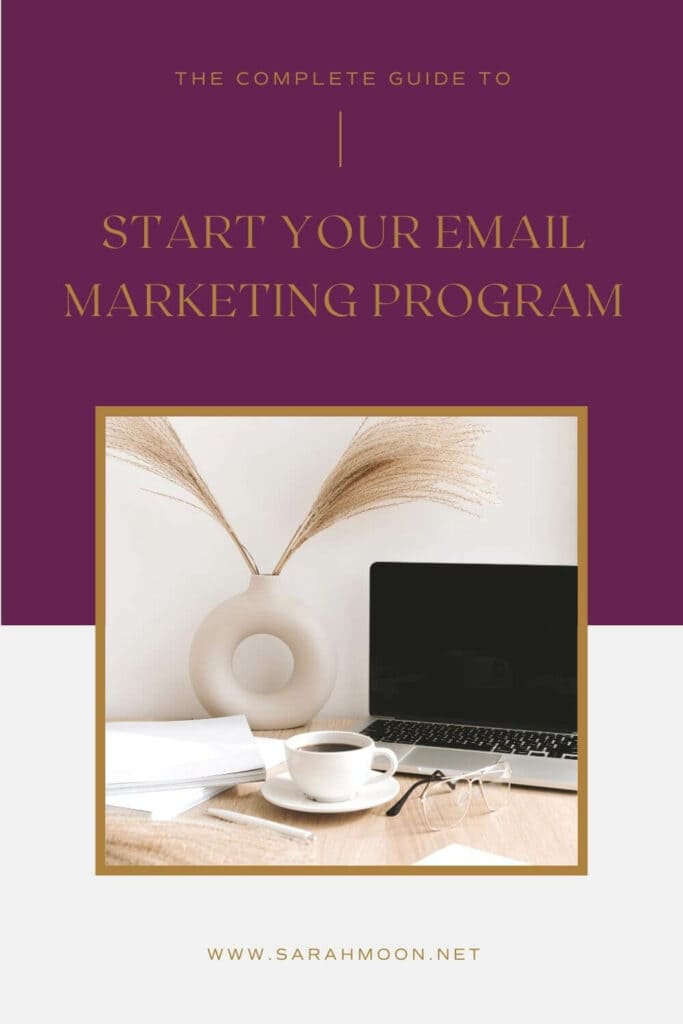Did you know that email marketing has the highest return on investment for small businesses?
source: Campaign Monitor 2019
That’s right. It has an ROI of over $40 USD for every $1 USD invested.
The numbers are clear. It’s time to get serious about your email marketing plan—and start making connections with your audience in their inbox.
But there’s definitely a right and wrong way to go about it. Being invited into someone’s inbox is a privilege, and it’s one you don’t want to waste!
Let’s cover four steps in the email marketing process:
- Address your mindset around email marketing
- Questions to ask before you choose an email marketing platform
- How to choose an email marketing platform based on your specific needs
- How to make and document your email marketing plan

Step One: Address Your Mindset Around Email Marketing
Most people treat email as an obligation and a “broadcast” – an outward message meant to convert to sales immediately.
This approach, for most businesses and organizations, is a short-sighted perspective. An email newsletter is an opportunity to build a relationship, grow your voice, and connect directly with your audience. Moreover, something magical happens when people start replying to your email newsletters: you learn.
People tell you their pain points, products they’re hoping to find, and what issues matter to them.
Yes, they literally reply to your emails. And you have a conversation. In your inbox.
So, rather than thinking, “How can I build my list so I can sell more products/services/whatever?” starting thinking, “If I build my list, how can I forge relationships with my readers?”
Step Two: Questions To Ask Before You Choose an Email Marketing Tool
With this new mindset, it becomes much easier to choose a newsletter tool that fits your needs. You can ask yourself:
- Have I budgeted for a monthly expense, or do I need to keep it free for now? If your list gets big enough, you’re going to have ongoing costs no matter what. Plus, this is an extremely valuable tool, so it’s typically better to budget for it than scrimp.
- Will my emails be mostly regular (hopefully weekly) informational and educational messages?
- Am I going to have a lot of content upgrades/lead magnets and put those folks in a sequence before I start emailing them regularly?
- Will I have a variety of segments that need different pieces of information from me (for example, if you have both a B2B and B2C audience)?
- Do I want an all-in-one tool, or am I happier with a “right tool for the job” type approach? Pro tip: All in one can be appealing but also limiting.
- Do I expect my newsletter tool to act as a CRM, or do I already have something that meets that need?
- How important is a highly designed newsletter to my brand? (Spoiler alert: I will die on the hill that it’s only essential to a particular subset of marketers.)
- What are my data collection obligations, such as GDPR, business insurance, or privacy rules in my specific industry?
Write down all these answers before proceeding to the next step!

Step Three: How To Choose an Email Marketing Tool
Sometimes choosing a tech tool can be distracting for folks, and I get it—it seems overwhelming, and it’s something that stinks to get “wrong.”
With that said, what’s right for you now, may not be right for you in a few years, and that’s okay; as long as your data is reasonably portable, make the best decision you can right now, not focusing on what-ifs.
Remember those answers from the previous step? Pull that out now and follow along—those answers should guide you through this step.
Email Marketing for People on a Budget
If your business or organization is more of a side hustle with little or no operating budget, it’s okay to prioritize the money side. Just be aware that with all budget-driven decisions, there may be trade-offs.
ConvertKit
ConvertKit is free up to 1,000 subscribers but does not include the fancy automation and sequences of paid ConvertKit accounts. The free version does have tagging capabilities and broadcasts, but that’s essentially where the free features stop.
For people for whom conversation-style email marketing strategies (like mine), this is my go-to recommendation.
ConvertKit does one thing very well – comprehensive mailing list management. It’s not trying to be all things to all people. It’s just sitting there in the background specializing in great email marketing. People who are still attached to fancy-looking emails will be disappointed in ConvertKit, however.
(Fancy-looking emails aren’t necessary, here’s some reading that aligns with my thinking on this.)
I also love that ConvertKit is a boot-strapped company not beholden to investors but instead to customers. This approach results in a different experience when you need customer support, and our team has seen the company incorporate customer feedback into the product many times.
MailerLite
MailerLite is my current favorite free option because the company includes all features in the free plan up to 1,000 subscribers and 12,000 email sends per month.
MailerLite is a relative newcomer to the game, and the tool is powerful enough to be beneficial to even the free users. Automations are very simple to set up and manage, as are the tagging system and form management.
Most people will inevitably need to move up to a paid tier, so it’s helpful to keep that in mind. However, even the base paid plan is less than $100.
Mailchimp
Mailchimp is also free up to 1,000 subscribers, however, with limited automation at the free tier. Mailchimp used to be a go-to recommendation because the free level was so appealing, and it worked well with Squarespace, which many of our clients use.
However, I’ve personally never enjoyed using Mailchimp and find the interface absolutely maddening. With that said, you can seriously grow with Mailchimp, and it has over 11 million users. A word of advice – manage your audience and segments correctly, as Mailchimp can get messy quickly. The company has faced a lot of very valid criticism over its company culture in recent years. Intuit recently acquired the company, so the outcome of this development remains unknown.
Squarespace Campaigns
Squarespace Campaigns starts at $5 per month. We like this option for Squarespace users who are just beginning with email marketing.
I have very little (well, no) information about their deliverability rate at the moment. But if you’re a Squarespace user and want easy click and send emails, especially blog posts to newsletter emails, you may want to look at Campaigns.
It’s a bare-bones platform at the moment because email is all about messaging, its focus on email aesthetics bothers me. I worry people will be distracted by trying to design an email that looks like a website.

Email Marketing for People on a Budget
Our Top Recommendation: Klaviyo
Our resident e-commerce expert Valarie recommends Klaviyo as the go-to for serious shops. Klaviyo is the Cadillac of email marketing tools for stores and has everything you need, including abandoned cart messages and extremely granular segmentation.
What’s also appealing is that they have texting plans, which are very effective for certain businesses. It also has robust CRM capabilities and plays nicely with Shopify. Klaviyo bases its pricing on subscriber counts, while texting and email contacts have separate pricing. You can estimate your costs on their pricing page.
Drip
Drip’s pricing is also based on subscribers and starts at $19 per month. Drip focuses on e-commerce, so if you’re primarily a store, this platform may serve you well. It also has many customer-behavior-based segmentation options, so, again, if you’re operating a store, this can be a great option.
ConvertKit
If your products are digital (such as courses), there’s a good chance your product platform will integrate and segment your list based on purchases. (Our Podia content is set up this way in ConvertKit, and it’s excellent.) ConvertKit is also soon introducing its own digital sales tool inside landing pages, including paid newsletters and other subscriptions.
I can’t recommend MailChimp for e-commerce anymore as they seem to have loads of connectivity issues these days and are in spats with other platforms.
Email Marketing Options if Customer/Lead Data Is Your Top Priority
ActiveCampaign
Pricey! Okay, full disclosure, I personally hate working with ActiveCampaign. But, if you’re looking for an email marketing tool that can do double-duty as a CRM (customer relationship management) tool, it may be worth looking at for you.
Because of its complexity, I believe that ActiveCampaign users should be at the “Professional” tier—it’s just that easy to mess up, and you want to have a support lifeline if you need help.
Klaviyo
Again, this is recommended for a very deep customer behavior integration and is pretty exciting for highly targeted marketing.
Email Marketing Options for People Who Absolutely Won’t Be Persuaded and Demand a Highly Designed Email Newsletter
Flodesk
Flodesk’s official cost is $38/month for unlimited subscribers, but everyone (including me) has discount codes that make it $19/month.
I like Flodesk for “pretty” emails more than Squarespace Campaigns as they do have pretty slick functionality, nicer automation features, and are just a more developed product. However, my big worry about them (aside from focusing on newsletter design) is their strength: the flat fee, unlimited pricing.
Email marketing platforms are costly to run. And, it gets more expensive as users send more emails. Therefore, I’m not sure how they can scale unless they plan to take on more and more investors, which leads to a company that’s real customers are their investors.
Email Marketing Options for People Who Simply Want To Write a Newsletter and Organize Their Subscribers
(Drumroll, please)
Top choice: ConvertKit
At this point, I sound like a pusher, and that’s because ConvertKit literally helped me transform my business. I am not remotely exaggerating.
Second choice: MailerLite
It’s just that simple and easy to use.
Both options are mature products designed for the most common email marketing uses and make automation and segmentation pretty much a no-brainer. As a result, I feel confident recommending both to the vast majority of the people we work with, who primarily run service-based businesses.
But what about Constant Contact?
Hard pass. Just say no to Constant Contact, people. Good grief, do not make yourself miserable with that mess.

Step Four: Document Your Email Marketing Plan
Yes, choosing your email marketing tools is a required step. However, here’s something else to consider—what’s your email newsletter plan?
Here are some things to ask yourself as you’re making your plan:
- How often will I email my audience?
- How will I grow my list?
- What kind of “list hygiene” do I need to do? (This means making sure your list is full of people who want to hear from you—I purge my list every couple of months at least.)
- Am I going to create evergreen content that people get in a sequence, or will I write new stuff on a schedule?
- How will I keep my list engaged?
There aren’t right or wrong answers to these questions, but they’re essential to keeping in mind as you craft an initial sketch of your plan.
The other thing to keep in mind is the answer to, “What are my big newsletter themes?”
These themes should connect to your content marketing strategy that you’ve hopefully outlined as part of your content cluster (Be sure to watch our webinar replay about content clusters!)
While I’m a massive fan of giving yourself space to create content as the tides ebb and flow, you need to have some big picture themes in mind.
For example, here are some of the big themes I repeatedly tackle in my newsletter:
- Engineer Luck (SEO & conversions)
- Streamline Your Systems (like this content right here)
- Commit to Content (content will carry you far)
- Pinpoint Your Perspective (the importance of point of view)
These themes generally fit in line with my public-facing content marketing strategy but with less emphasis on keywords. Instead, the newsletter is more conceptual. Likewise, the blog (which brings in a broad audience) more precisely targets the goal of bringing traffic to generate (you guessed it) newsletter signups.
Next, ask yourself what your calendar will look like in terms of sending emails. Be sure to account for both regular “broadcasts,” any announcement content or new product stuff, and any evergreen sequences people will receive.
If you’re using the latter, be sure to decide if you will exclude those people from the other email types while they’re in your sequence or not. (I typically say yes).
Wondering How and When To Schedule Your Emails?
Here are my general recommendations:
- Work up to a once-a-week schedule. I know this sounds like a lot, but you can do it! (But it’s also okay to start with once a week or every two weeks.)
- Try to send your emails on the same day, at roughly the same time. Consistency is critical for newsletter success.
- Be reasonably consistent with your other messages, such as products, announcements, etc.).
When you work through all of these steps, you’ll have a general plan for your email marketing newsletter. And beyond that, you’ll have a roadmap to guide your technology needs.
I encourage you to write down your plan as you work through these steps. The documentation process will help you see how your newsletter fits with your overall marketing plan.
Does this sound overwhelming? It’s not! Take each step, one by one, and work through it. Before you know it, you’ll have a systemized, structured email marketing program that earns you revenue and builds authenticity with your audience.
Are you wondering how email marketing fits into your overall marketing plan? Schedule a one-on-one strategy session with Sarah and get professional help to determine your best next step!






 & Our Favorite Portland Coffee Shops
& Our Favorite Portland Coffee Shops
2 Responses
Love this Sarah! ConvertKit is my favorite tool and the automation tools are so worth it!
ConvertKit does email so, so well, it’s what I recommend much of the time!